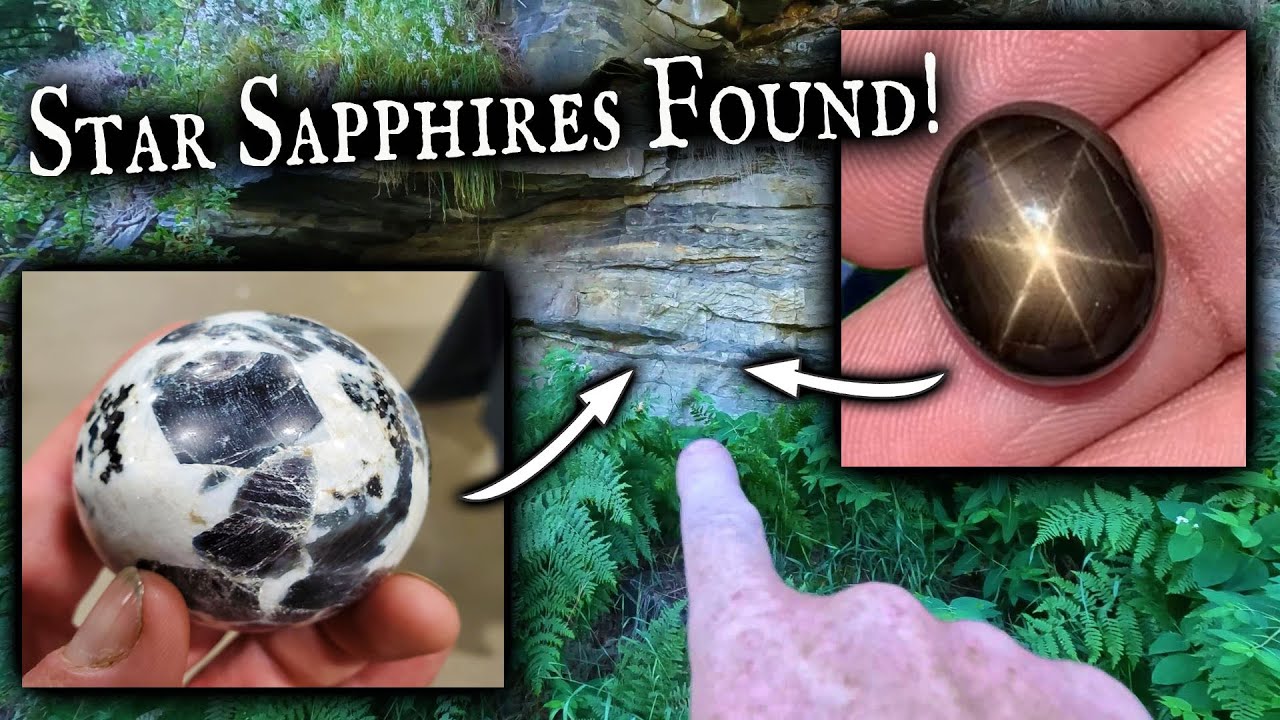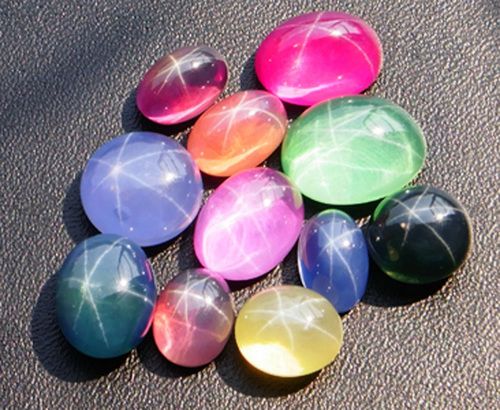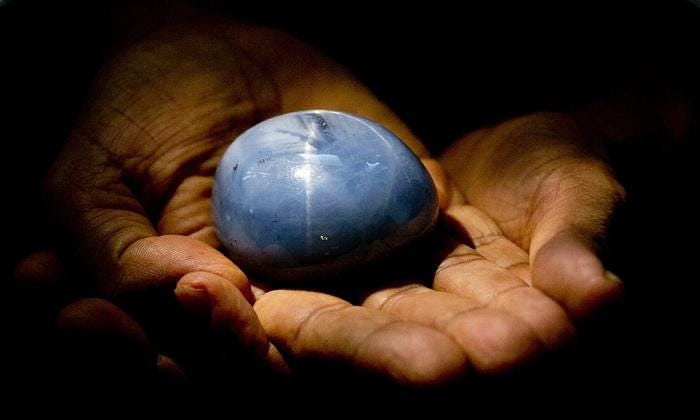Have you ever heard about star sapphirestone? The star sapphiregemstone is one of the most popular in the world and is highly prized by collectors and jewelrynature lovers.
Where does its name come from? Is it in the shape of a star?
What Makes A Sapphire A Star Sapphire?
Because it exhibits a star-like phenomenon known as asterism, this particular variety of sapphire is referred to as a star sapphire.
When viewed from above, star sapphires take on the appearance of a six-rayed "star" due to the needle-like inclusions that are aligned with the crystal structure and give them their distinctive appearance.
Inside, one frequently comes across the mineral rutile, which is composed of titanium dioxide for the most part.
Therefore, it is not the stone itself that has the appearance of a star; rather, the stones are simply reflecting light in the form of a star, which gives them that appearance.
The star effect is not the same thing from one instance to the next. It is caused by the way light travels through the stone, and it shifts in appearance depending on the vantage point from which it is observed.
The topic of star sapphires' clarity is a difficult one to resolve. The perfect star sapphire would have no inclusions or cloudiness whatsoever; nevertheless, the rutile silk, which is responsible for the star phenomenon, ensures that every star sapphire is at least somewhat cloudy.
This is due to the fact that the rutile silk gives the appearance of stars. Fine star sapphires need to have just the proper amount of silk to create a brilliant and clearly defined star, but not so much that the stone becomes cloudy.
Facts
No cleavage can be seen in this material. It has a hardness of 9 on the Mohs scale. Star sapphire is made up of aluminum oxide and forms crystals, which are made up of three pieces.
As a result of star sapphire's superior hardness and durability, it's almost impossible to tell apart from other gems that have the same colors and sparkle.
They Don’t Just Come In Blue!
The following picture is representative of the most prevalent color of this stone, which is blue. Even more varieties of sapphires are available. Dark blue sapphires are the most prevalent color, but yellow, green, and even pink sapphires have been seen on occasion.
One Of The Rarest Stone
In addition to being found in all of the many colors of corundum, star patterns may also be discovered in a variety of other gemstones. Garnet, diopside, and spinel stones have all had star impurities discovered in them, which is an extremely unusual occurrence.
Largest Star Sapphire
Because it is extremely difficult to come across enormous sapphires, and because finding large star sapphires is next to impossible. People are aware of it due to the fact that it is a blue star sapphire weighing a significant amount that has 1404.49 carats.
This precious gem is known as "The Star of Adam," and it was discovered in the southern region of Sri Lanka. The largest blue star sapphire ever discovered was uncovered at that location.
The 'Star of Bombay' is the name given to another impressively sized blue star sapphire. In addition to being a blue star sapphire, this one weighs in at 563.4 carats.
This particular black star sapphire is the largest one ever found. The name of this artwork is "Black Star of Queensland." It is the black star sapphire of the highest quality and measures 733 carats, making it the largest black star sapphire ever found.
When grading star sapphires, factors like asterism's intensity, visibility, and hue are taken into account as well. The color of sapphire and its weight are the two characteristics that are most frequently used to judge its quality.
If you are interested in acquiring a sapphire, you should have an educated professional evaluate not only this facet of the stone but also the other important facets of the gem before making your purchase decision.
Have a look at our assortment of jewelry that is set with sapphires, as well as our gemstone shop, where you may go on a treasure search for sapphires.
Synthetic Type
A synthetic variety of star sapphire that is extremely comparable to the natural variety has been developed by specialists. You'll find that the majority of the time, it appears to be too good to be true. To identify the real star sapphire, you can follow these steps:
How To Identify
- First, look for flaws in the stone. Stripes or lines of color also appear on the bottom.
- It shows from the top. Natural star sapphires almost always have one or more of these natural flaws, but not all of them.
- It comes through the top. Most natural star sapphires have one or more of these natural flaws, but they don't all have them.
- Then, look at the star. A flashlight. There aren't many natural stars that have the same kind of star that we have.
Where Can You Find Star Sapphire?
It is imperative that you are aware of the locations at which this priceless gem can be discovered if you have any intention of purchasing a star sapphire. Here are some key locations where star sapphires are known to be found:
- Sri Lanka- Sri Lanka, formerly known as Ceylon, is renowned for its rich gemstone deposits, including star sapphires. The island nation has a long history of producing high-quality gemstones, and star sapphires from Sri Lanka are highly sought after due to their exceptional color and distinct asterism. The city of Ratnapura, meaning "City of Gems," is a prominent hub for gem mining and trade in Sri Lanka.
- Myanmar (Burma)- Myanmar is another significant source of star sapphires. The Mogok Valley in northern Myanmar is particularly famous for its exceptional gemstone deposits, including star sapphires. Known as the "Valley of Rubies," Mogok has been a center for gemstone mining for centuries and continues to produce some of the finest star sapphires in the world.
- Thailand- Thailand has a long-standing tradition in the gemstone trade and is recognized for its expertise in gem cutting and polishing. The country is also known for its star sapphire deposits, particularly in the Chanthaburi province. Thai star sapphires are valued for their vibrant colors and excellent asterism.
- Australia- Australia is home to several notable star sapphire deposits. One of the most famous sources is the Anakie region in Queensland. The gem-rich area produces star sapphires of various colors, including blue, green, and black. Other Australian locations known for star sapphires include New South Wales and Northern Territory.
- India- India has a long history of gemstone mining and is known for producing a wide variety of gemstones, including star sapphires. The state of Jammu and Kashmir, in particular, is renowned for its star sapphires. Kashmiri star sapphires are highly prized for their deep blue color and exceptional asterism.
- Madagascar- Madagascar is an emerging source of star sapphires. The island nation is known for its diverse range of gemstone deposits, and star sapphires are among the treasures found there. Deposits in areas like Ilakaka and Ambatondrazaka have yielded impressive star sapphires with vibrant colors.
- United States- While not as well-known as some other countries, the United States also has regions where star sapphires can be found. Montana, in particular, is famous for its Yogo Gulch deposit, which produces unique blue star sapphires. Other states like North Carolina, Idaho, and Oregon have also produced star sapphires.

Found Beautiful Star Sapphires on my New Sapphire Site!
It is essential to keep in mind that the availability and quality of star sapphires might differ from location to location, despite the fact that particular geographic areas are famous for the star sapphire deposits they contain.
In addition, the mining of gemstones should adhere to the highest standards of morality and responsibility in order to protect the surrounding environment and guarantee that workers are treated fairly.
Why People Should Start Investing In Star Sapphire?
- Rarity- Star sapphire is relatively rare compared to other gemstones, making it a highly sought-after and exclusive investment. Its scarcity adds to its desirability and potential for long-term value appreciation.
- Aesthetic Appeal- Star sapphire showcases a mesmerizing star-like pattern known as asterism. This phenomenon is created by the presence of needle-like inclusions that interact with light to form a star-shaped effect. The visual allure of a well-defined star shimmering across the gem's surface is truly captivating and adds to its aesthetic appeal.
- Durability- Sapphire is one of the hardest gemstones, ranking 9 on the Mohs scale of mineral hardness. This exceptional hardness makes star sapphire highly durable and resistant to scratches, making it suitable for everyday wear and minimizing the risk of damage.
- Symbolism and Significance- Throughout history, sapphire has been associated with numerous symbolic meanings and beliefs. It has been regarded as a stone of wisdom, royalty, and divine favor. In various cultures, sapphire is believed to bring protection, good fortune, and spiritual enlightenment. The symbolic significance of star sapphire adds to its allure and makes it a cherished gemstone for both personal and investment purposes.
- Investment Potential- Star sapphire has been recognized as a valuable investment option, with prices steadily appreciating over time. As the demand for rare gemstonesincreases, star sapphire's limited supply and unique optical phenomenon make it an attractive choice for investors looking to diversify their portfolios.
It's important to note that investing in gemstones, including star sapphire, requires careful consideration and research.
Some additional factors to consider include gemstone quality (color, clarity, and cut), certification from reputable gemological laboratories, and market trends.
People Also Ask
Can Star Sapphires Be Treated Or Enhanced?
Yes, some star sapphires undergo heat treatment to improve their color and clarity. However, the presence of asterism is a natural phenomenon and cannot be created or enhanced through treatments.
How Should I Care For My Star Sapphire Jewelry?
Star sapphires are relatively durable gemstones, but they should be handled with care to avoid scratches and impacts. Clean them gently using a soft cloth and mild soapy water, and avoid exposing them to harsh chemicals or high temperatures.
Can Star Sapphires Be Used In Engagement Rings?
Yes, star sapphires can be a unique and beautiful choice for an engagement ring. They offer a distinctive look and are known for their symbolism of wisdom, protection, and intuition.
Conclusion
Sapphire comes in two varieties: synthetic and natural. However, it is still one of the best sapphire stones you will come across. They can amaze you with the reflections they produce. Not everyone has the opportunity to touch or see one in person, so if you have one, learn to value it!

